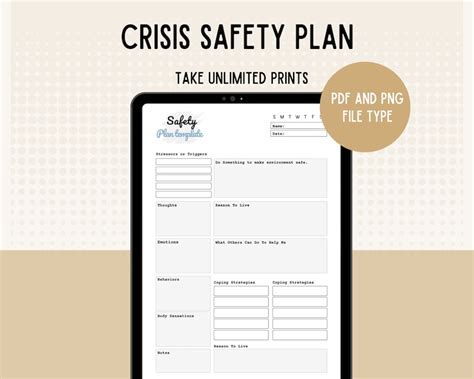Creating a suicide safety plan is a crucial step in managing mental health crises, especially for individuals who have experienced suicidal thoughts or have been diagnosed with mental health conditions that may increase the risk of suicide. This comprehensive guide aims to provide a detailed overview of what a suicide safety plan is, its components, and how to create one. It also offers insights into crisis support and resources that can be invaluable during difficult times.
Introduction to Suicide Safety Plans
A suicide safety plan is a personalized, written document that outlines the steps an individual can take to manage suicidal thoughts and behaviors. It serves as a proactive strategy to ensure safety during crisis situations. The plan is typically created in collaboration with a mental health professional and involves the individual, their family members, friends, and other support systems.
Components of a Suicide Safety Plan
Warning Signs: Identifying personal warning signs that indicate the onset of a mental health crisis. These can include feelings of hopelessness, anxiety, changes in mood, or other emotional and behavioral changes.
Internal Coping Strategies: Listing coping mechanisms and techniques that the individual finds helpful in managing distress. Examples include relaxation techniques, creative activities, or physical exercises.
People to Contact: Naming friends, family members, or mental health professionals who can provide support during a crisis. Including contact information is crucial for easy access.
Places to Go: Identifying safe locations where the individual can go to feel safe and distracted from suicidal thoughts. This could be a friend’s home, a community center, or a crisis center.
Professional Help: Including contact information for Mental Health Professionals, Crisis Hotlines, and Emergency Services. Examples include the National Suicide Prevention Lifeline (1-800-273-TALK (8255)) in the U.S.
Restricting Access to Means: Strategies for limiting access to means that could be used in a suicide attempt, such as firearms, medications, or other potentially lethal objects.
Follow-up: Planning follow-up appointments with mental health professionals after a crisis to review the safety plan and make necessary adjustments.
Creating a Suicide Safety Plan
Creating a suicide safety plan involves several steps:
- Collaboration: Work with a mental health professional to develop the plan. Their expertise can help tailor the plan to the individual’s specific needs.
- Honesty: Be honest about personal struggles, feelings, and experiences. This openness is crucial for creating an effective plan.
- Review and Update: Regularly review the plan and update it as necessary. Circumstances, support networks, and personal coping strategies can change over time.
- Sharing the Plan: Share the plan with trusted individuals and make sure they understand their roles in supporting the individual during a crisis.
Crisis Support and Resources
Crisis support is a vital component of any suicide safety plan. It includes immediate interventions designed to de-escalate crisis situations. Key resources include:
- Crisis Hotlines: 24⁄7 services that provide immediate support and guidance. They can connect callers with local resources and professionals.
- Emergency Services: For immediate danger, calling emergency services or going to the nearest emergency room can provide the necessary level of care.
- Online Resources: Many organizations offer online chat services, forums, and information portals that can provide support and guidance.
Implementing the Plan
Implementing a suicide safety plan requires commitment and support from all parties involved. It’s essential to:
- Act Quickly: If experiencing suicidal thoughts, act on the plan without delay.
- Communicate Openly: Keep lines of communication open with support networks and professionals.
- Seek Help: Never hesitate to seek help. Reaching out is a sign of strength, not weakness.
Conclusion
A suicide safety plan is a powerful tool for managing mental health crises. By understanding its components, creating a personalized plan, and leveraging crisis support resources, individuals can better navigate difficult times. Remember, safety is just a step away with the right support and resources. If you or someone you know is struggling with suicidal thoughts, please reach out to a mental health professional or a crisis hotline today.
What is the first step in creating a suicide safety plan?
+The first step in creating a suicide safety plan is collaborating with a mental health professional. They can help identify personal risk factors, coping strategies, and support networks that are crucial for the plan.
How often should a suicide safety plan be reviewed and updated?
+A suicide safety plan should be reviewed and updated regularly, ideally every 3 to 6 months, or as needed based on changes in circumstances, support networks, or mental health status.
What are some signs that someone may be at risk of suicide?
+Signs that someone may be at risk of suicide include talking about wanting to die or kill themselves, expressing feelings of hopelessness, increased substance use, and withdrawing from social interactions. If you notice these signs, encourage the person to seek professional help immediately.
How can I support someone who has a suicide safety plan?
+To support someone with a suicide safety plan, ensure you understand their plan, encourage them to follow it during crises, offer to help them stay connected with their support networks and professionals, and know how to contact emergency services if necessary.
Is a suicide safety plan only for individuals with a mental health diagnosis?
+No, a suicide safety plan is not only for individuals with a mental health diagnosis. Anyone can experience suicidal thoughts or feelings, and having a plan can provide a sense of security and support. It's beneficial for anyone who has considered or experienced suicidal ideation or behaviors.
Creating a suicide safety plan and understanding crisis support resources are key steps in protecting one’s mental health and well-being. Approach these topics with care, compassion, and a commitment to seeking help when needed. Remember, mental health support is always available, and reaching out for help is the first step towards healing and recovery.


